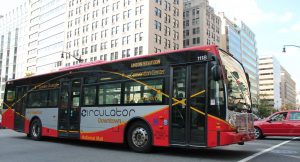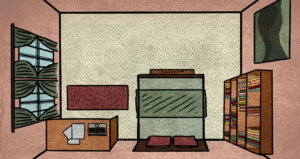While Georgetown’s location atop a hill provides an excellent view of the Potomac and the nation’s capital, it makes the university’s campus inaccessible for a significant portion of its population. To combat the school’s inaccessible environment, several student leaders had created an Americans-with-Disabilities-Act-compliant student-run shuttle program, which was set to launch on Sept. 13. However, university administrators announced on Oct. 18 that the project was placed on an indefinite pause likely to continue until the next academic year.
Less than one-fifth of undergraduate students currently believe that Georgetown’s campus is physically accessible to students with disabilities, according to the results of the cultural climate survey released earlier this year. The university does not provide personalized transportation services to students who have mobility disabilities and is not legally mandated to provide support to students with “temporary” impairments. However, the student leaders behind the new program, HoyaLift, believe the university should go beyond the minimum legal obligation.
“Our end goal is for all community members to feel as if campus is as accessible as possible,” Dominic DeRamo (COL ’23) said in an interview with the Voice when the shuttle program was first announced. “We really want to minimize the workarounds that people have to take in their everyday life for the betterment of everyone’s campus experience.”
The proposed schedule HoyaLift would run from 9:00 a.m. to 5:00 p.m. Monday through Thursday and 9:00 a.m. to 3:00 p.m. on Fridays with the goal of improving accessibility for students on campus. However, administrators, concerned with the logistics of implementing a successful pilot into a permanent service run by the university, have put the program on pause, according to Nesreen Shahrour (NHS ’23).
HoyaLift’s goal is to safely remove barriers that Georgetown’s campus poses for students and increase students’ opportunities to fulfill their academic and personal potential. It also hopes to fill gaps in the university’s current transportation services, which are often insufficient to meet the needs of students. SafeRides, a university shuttle program designed to offer a safe alternative to walking alone at night, only runs for a handful of hours after 8:00 p.m each night of the week. The university also operates an ADA-accessible Mini-Shuttle Bus Service, but transportation is limited to patients and staff traveling between the McDonough Arena and the MedStar Georgetown University Hospital.
While there are other university programs designed to make Georgetown more accessible, these do not focus on transportation. The Academic Resource Center (ARC), for instance, accommodates students academically by granting students excused tardiness rather than providing services to assist with getting to class on time. While Student Health Services has the ability to provide mobility devices, like crutches, to students, it has yet to tackle the inaccessibility inherent in Georgetown’s campus environment.
“HoyaLift will not solve all of the university’s accessibility problems, but we hope that it is a step in the right direction towards providing accessibility to students because we understand how hard it is not just to navigate campus but to feel included in a space that you can’t even access,” DeRamo said.
A similar shuttle program—Hoyability—received university funding and approval in 2017, but it was never implemented. Two years later, Olivia Silveri (NHS ’21) would go on to found HoyaLift, the beginnings of the shuttle program set to launch this September.
“We all understand that not only are we serving disabled people—who make up 14.4 percent of our undergraduate population—but we are also serving people who are going to come in and out of disability during their time at Georgetown,” DeRamo said of the program’s goals. The higher student demand, DeRamo explained, the more evidence builds for the necessity of the program.
HoyaLift’s launch encountered difficulties before it was put on an indefinite pause. The program’s organizers worked through the summer into the first few months of fall to develop the logistics of the program, including establishing the shuttle’s route, writing an employee handbook, formalizing interview questions for staff, designing a logo, putting up signs, advertising, and hiring coordinators and drivers. This work was done solely by students, with infrequent check-ins with administrators that seemed to indicate the pilot´s launch date would pose no problem.
“Traditionally, this kind of program at another university would be operated by a well-experienced department with tons of resources, tons of time, and ultimately, a fully-paid salary, but instead it’s a student-run program,” Gwenyth Murphy (SFS ’23) said. While the team had been working with several members in the administration to gain approval and funding through a federal work-study program, the program itself was entirely student-run.
Despite the efforts from the student team, administrators have placed the program on an indefinite pause, according to Shahrour. “It appears that administrators want to reevaluate the program, specifically logistics about how the program will be implemented and the logistics behind the longevity of the program,” Shahrour said. “I think they’re worried about offering a service and then how to go about continuing the service after the pilot.”
The decision was announced to the student organizers in a meeting with Dr. Jeane Lorde and Dr. Erika Cohen-Darr, the Interim Vice President for Student Affairs and Dean of Students in a meeting on Oct. 18. The HoyaLift team was frustrated and devastated after the announcement, according to Shahrour.
The pilot, which had been on temporary pause during the pandemic due to a lack of access to campus, had been set to launch in early September, with no indication the program was going to be reevaluated or delayed by nearly a year, according to Shahrour. It had received $9,000 in funding from the Social Innovation and Public Service (SIPS) Fund, which works to help students and alumni finance their own ventures, as well as funding from the federal work-study program.
“It has not been clear, honest communication from the administrator’s end,” Shahrour said of the complicated and often contradictory back-and-forths the student leaders would have with different administrative groups. The Office of Transportation will say one thing, which will often be contradictory or unrelated to what the Office of Student Affairs says, Shahrour noted.
The student organizers hope the program will eventually be implemented and help attract aspiring Hoyas who might otherwise view the campus as too inaccessible to even consider applying to school on the Hilltop. “Implementing this project and having it be a long-lasting program will show huge effort on the university’s end in creating a more accessible campus and that the university values disability and disabled students, which could lead to disabled students coming to campus,” Shahrour said.
Despite the setback, the team has focused its energy on short-term projects to address other accessibility issues on campus and work with the GUSA Accessibility Policy Team, even as talks concerning HoyaLift continue with administrators. Their focus includes ADA-compliant door-opener buttons, physical accessibility of Casa Latina and the Black House, and a form where students can report non-functional items, especially as it relates to ADA-compliant changes for students with disabilities and their ability to get around campus.





